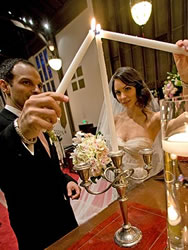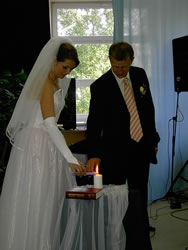Ceremony Services
Unity Candle Lighting Ceremony
 
The unity candle lighting ceremony is becoming more and more common in today's weddings. The ceremony symbolizes the pledge of unity between the bride and groom and the merging of two families. It usually occurs after the exchanging of rings and before the couple is pronounced husband and wife (sometimes it is done after this however). Usually the mothers light their tapers before taking their seats, usually to a special piece of music. (This is often an instrumental song so as to not take any attention away from the mothers.) When the bride and groom light the center candle, a song is sung or played. They either take a few minutes up by the altar to exchange a few words or they can take a flower that was placed by the candle and present it to their mothers at this time.
Traditionally, there are three candles. The mothers each light one of the side candles. The bride and groom then each take one of the side candles and together they light the center candle. They may then blow out their individual side candles to symbolize the extinguishing of their two single lives. Or, as is more common today, they may keep those candles burning to symbolize that their individual ness is not extinguished, even though they are united in marriage.
The 5 W's of Your Unity Candle Ceremony
Who?
The obvious answer is the bride and groom, but many choose to have more people involved. You can include your parents, your grandparents, and your children in the lighting of candles before the Unity Candle ceremony.
What?
The Unity Candle hit the wedding scene in the early 1990's. Couples use two lit taper candles (symbolizing their individuality) to light one big candle as a symbol of their two lives becoming one in commitment. Most Unity Candles were used in Protestant churches or in wedding ceremonies not conducted in church. Although more accepting of it today, many Catholic or Jewish ceremonies ask that couples not include the candle in the ceremony, since the Unity Candle is not a part of the traditional wedding liturgy.
Usually during the processional, the mothers of the bride and groom light a taper candle in honor of their son or daughter at the altar or a small table at the front of the church. They return to their seats, and the tapers remain lit throughout the ceremony. After the vows and rings have been exchanged, the minister will explain to the guests the symbolism of the Unity Candle. He asks the bride and the groom to take their "individual" lives (the individual taper candles) and bring them both to the large center candle, lighting one flame with their two individual flames. During the lighting of the Unity Candle, many times couple will have a song sung or played, or the minister will recite an appropriate poem to accompany the symbolism of the ceremony.
Whether or not to extinguish the individual tapers after the lighting of the Unity Candle is up to the couple. Many couples believe that putting out individual flames appears as if their individual lives have been snuffed out for the benefit of the marriage, while some believe extinguishing individual candles only shows their devotion to the commitment they've just made. According to most ministers, the decision is left entirely up to the couple.
Where?
The Unity Candle ceremony can be performed at the altar, off to the side of the altar at the front of the church, not in a church at all, and last but not least, outside. Many Officiants worry about performing such a delicate ceremony outside, because the "forces of nature" may provide obstacles to lighting the candles. As Judge Carolyn Hayek told us, "Unity candles pose a number of challenges. Will the wind blow out the candles? Will there be a problem lighting the candles? Sometimes candles quite stubbornly refuse to be lit, especially if it is difficult to get the lighting candle close to the wick of the candle to be lit. What's the backup plan if the candles go out or refuse to be lit?" If you're planning on performing your Unity Candle ceremony outside, be sure to practice with your hurricanes on a day with plenty of wind to make sure you can finish the ceremony without frustration.
When?
Where you place the Unity Candle ceremony within the wedding ceremony is up to you although most Officiants we spoke with suggested waiting until after you've said your vows and exchanged your rings to light the candle. Reverend Gerald Montgomery comments, "Every so often I encounter a bride who wants to begin the wedding ceremony with a unity candle. That's the equivalent of putting a cart in front of a horse. First, the marriage must be created, then it can be celebrated. A unity candle moment in a wedding ceremony is a liturgical celebration of this new relationship between the bride and groom."
But, Rabbi David Roller made a great point: "I like the use of a unity candle as a beginning for a wedding ceremony as it symbolically shows the couple as coming together. It is not particularly religious as fire is a universal element. I also like the unity candle at the end. It really does add a nice element to all ceremonies."
Why?
The reasons why to include the Unity Candle in your ceremony, at least the reasons we received from the Officiants we interviewed, were varied but all had a central theme: a symbol of unity is always a beautiful thing. Rev. Dr. Bill Levering says, "It is a nice counterpoint to the rings: some things in a marriage are more ephemeral and need tending and protection like a flame." Rev. Colleen McLain insists on each ceremony being different: "I always urge them to make the candle lighting unique in some way, such as inviting the mothers or grandmothers up to the altar to light the individual candles, sometimes the moms and dads light them together. I think by making the ceremony unique, it means more in the long run."
We believe, though, that Reverend Maureen Jones-Ryan's explanation put it best: The Unity Candle Ceremony - like so many candle ceremonies - is a meaningful, spiritual symbol of Life, Light, and the Eternal Spirit of love and caring." Enough said.
|

